Did you know that the leaves of a pumpkin plant can grow up to 2 feet wide and take up as much as 300 square feet of space? That’s larger than the average kitchen! It’s no wonder that understanding how to cultivate and care for pumpkin plant leaves is essential for achieving lush and healthy growth.
Whether you’re growing pumpkins for Halloween decorations or culinary purposes, knowing the different stages of pumpkin growth is key. From planting and germination to vine growth and fruit development, each stage requires specific care and attention to ensure thriving leaves and a bountiful harvest.
Key Takeaways:
- Understanding the stages of pumpkin growth is crucial for cultivating healthy leaves
- Proper planting, germination, and care during the seedling stage promote lush growth
- Main and secondary vines play a significant role in supporting foliage
- Male and female flowers require pollination for fruit development
- Harvesting at the right time and proper curing and storage practices ensure longevity and quality
Germination – Planting Pumpkin Seeds For a Successful Start
Germination is an essential stage in the growth of pumpkins, as it marks the beginning of their journey towards becoming vibrant plants. To ensure a successful start, it is crucial to plant pumpkin seeds in nutrient-rich soil with the right moisture levels.
The ideal soil temperature for germination is around 70°F, which provides the optimal conditions for the seeds to sprout and develop. It is advisable to plant pumpkin seeds in a sunny location after the last frost, as they thrive in warm and sunny environments.
When planting pumpkin seeds, it is important to allow adequate spacing between them. This prevents overcrowding and competition for nutrients, allowing each seedling to receive the nourishment it needs to grow and thrive. Adequate spacing also prevents the spread of diseases and pests among closely packed plants.
In addition to proper spacing, companion planting can also benefit pumpkin growth. Plants such as corn, beans, nasturtiums, and marigolds can be great companions for pumpkins. They provide natural pest control, attract beneficial insects, and improve soil quality, creating a conducive environment for pumpkin growth.
I’m always amazed at how a tiny seed can transform into a sprawling pumpkin vine. The germination stage is where it all begins, and with the right planting techniques, you can set your pumpkins up for success. Remember, providing nutrient-rich soil, proper moisture, and ample spacing are key elements in ensuring healthy and vigorous pumpkin seedlings.
After planting, pumpkin seeds will sprout within 7 to 10 days, revealing the first set of leaves called cotyledons. These cotyledons are crucial during the seedling stage as they provide food and nutrients for the developing pumpkin plants.
The emergence of cotyledons marks an important milestone in the growth of sprouting pumpkin seeds. These initial leaves are usually different in shape and color compared to the true leaves that will follow. Although they may not resemble the traditional pumpkin leaves, they play a vital role in nourishing the seedlings.
“The cotyledons provide necessary energy for the seedlings to establish a strong foundation for further growth.”
During this stage, it is important to maintain proper soil moisture. Overwatering can lead to root rot and other detrimental effects on the seedlings’ health. Regularly monitor the soil moisture and adjust your watering schedule based on the weather conditions to ensure consistent moisture levels.
Here are some essential tips for caring for sprouting pumpkin seeds:
- Water the soil gently to avoid disturbing the fragile seedlings.
- Water the plants in the early morning or late evening to prevent excessive evaporation.
- Avoid overwatering to prevent waterlogging and root rot.
- Monitor the soil moisture by checking its dryness with your finger.
Pumpkin Seedling Stage
As the seedlings continue to grow, they will develop their true leaves, distinct from the cotyledons. These true leaves resemble the traditional pumpkin leaves and are responsible for photosynthesis, converting sunlight into energy for further growth.
Proper care during the seedling stage is essential. Maintaining adequate sunlight, soil moisture, and nutrition will promote healthy growth and prepare the seedlings for the next stages of pumpkin development.
| Seedling Care Tips | Importance |
|---|---|
| Provide 6-8 hours of direct sunlight daily. | Promotes photosynthesis and healthy leaf growth. |
| Water the seedlings when the top inch of soil is dry. | Ensures adequate hydration without overwatering. |
| Apply balanced fertilizer every 2-3 weeks. | Provides essential nutrients for vigorous growth. |
| Protect seedlings from pests and diseases. | Prevents damage and ensures a healthy crop. |
Seedlings: the Emergence Of True Leaves & Their Importance
As pumpkin seedlings mature, they develop true leaves, distinct from the initial cotyledons. True leaves are responsible for photosynthesis, converting sunlight into energy for the plant’s growth.
Providing adequate sunlight and consistent soil moisture is essential during this stage. Insufficient sunlight can result in weak growth, while overwatering can lead to root rot and fungal diseases. Maintaining a balance between light and moisture will ensure the healthy development of pumpkin seedlings.
“The true leaves of pumpkin seedlings are crucial for the plant’s growth and development. These leaves have a higher surface area than the cotyledons, allowing for increased photosynthesis and energy production. Sunlight is essential for photosynthesis, so providing enough light is important for the healthy growth of pumpkin seedlings.” – Gardening Expert
The Significance of True Leaves
True leaves play a vital role in the growth of pumpkin seedlings. Unlike the initial cotyledons, which primarily serve as a food source for the seedlings, true leaves are equipped for photosynthesis. The process of photosynthesis converts sunlight into energy, fueling the growth and development of pumpkin plants.
During the seedling stage, it is crucial to provide the right conditions for optimal leaf growth. Here are some key factors to consider:
- Light: Pumpkin seedlings require ample sunlight to perform photosynthesis effectively. Placing them in a sunny location or using grow lights can provide the necessary light intensity for robust leaf development.
- Soil moisture: Consistent soil moisture is essential for the healthy growth of pumpkin seedlings. Overwatering can lead to root rot, while underwatering can cause stress and hinder leaf development. It is important to monitor the moisture levels and adjust watering accordingly.
Maintaining Healthy Seedlings
To ensure the optimal growth of pumpkin seedlings and their true leaves, a few additional tips can be followed:
- Provide adequate air circulation to prevent the development of fungal diseases. Good airflow helps keep the leaves dry and reduces the risk of diseases that thrive in damp conditions.
- Protect the seedlings from extreme weather conditions, such as strong winds or frost. Sheltering them with a lightweight cover or relocating them to a more protected area can safeguard their growth.
- Monitor for pests that may damage the leaves. Common pumpkin pests include aphids, cucumber beetles, and squash bugs. Taking preventive measures and using organic pest control methods can help preserve the health of the seedlings.
The emergence of true leaves signifies an important stage in the growth of pumpkin seedlings. By providing the right conditions and care, gardeners can ensure the development of healthy, robust seedlings ready for the next phase of their growth journey.
Pumpkin Vines: Growth Of Main & Secondary Vines
When it comes to pumpkin plants, the growth of main and secondary vines plays a crucial role in their overall development. Main vines serve as the primary growth stems, while secondary vines provide support and contribute to foliage growth.
Pumpkin vines have an incredible growth potential and can extend up to 30 feet long, requiring ample space in your garden or pumpkin patch. These sprawling vines need room to stretch and spread out, so keep that in mind when planning your pumpkin planting.
To ensure robust vine growth, providing the right nutrients is essential. A balanced fertilizer that contains nitrogen, phosphorus, and potassium is crucial for healthy vine development.
| Nutrient | Role in Vine Growth |
|---|---|
| Nitrogen | Promotes foliage growth |
| Phosphorus | Supports root development and flowering |
| Potassium | Important for fruit development |
By understanding the importance of these nutrients, you can provide the optimal conditions for your pumpkin vines to thrive and produce healthy foliage, flowers, and fruits.
Supporting Your Pumpkin Vines
Pumpkin vines tend to be heavy, especially as they grow and bear fruits. To prevent the vines from breaking or damaging the pumpkins, it’s crucial to provide adequate support. This can be done by using trellises, stakes, or even creating a structure using wire mesh or fencing.
When supporting your pumpkin vines, be gentle and avoid any unnecessary pressure or disturbance. Secure the vines loosely to the support structure to allow for growth and expansion.
“Supporting your pumpkin vines not only prevents damage but also allows for better airflow and sunlight exposure, promoting healthier growth.”
Care and Maintenance Tips
- Regularly inspect your pumpkin vines for any signs of pests or diseases and take appropriate measures to prevent or control them.
- Prune the vines if necessary to remove any unnecessary side shoots or damaged parts.
- Ensure the soil is consistently moist but not waterlogged, as excessive water can lead to root rot or other moisture-related issues.
- Consider mulching around the base of the plants to conserve moisture, control weeds, and regulate soil temperature.
By following these care and maintenance tips, you can promote the healthy growth and development of your pumpkin vines, setting the stage for a successful harvest.
With proper care, your pumpkin vines will flourish, creating a beautiful and bountiful display in your garden or pumpkin patch. The intertwining main and secondary vines will contribute to the overall health and productivity of your pumpkin plants, ensuring a successful growing season.
Pumpkin Flowers: Identifying Male and Female Flowers
When it comes to pumpkin plants, understanding their unique flower structure is crucial for successful pollination and fruit development. Pumpkin plants produce separate male and female flowers, each playing a specific role in the reproductive process.
The male flowers can be easily identified by their long stems and singular, pollen-filled stamen. These flowers typically appear first and serve the essential function of producing and distributing pollen. While male flowers do not develop into pumpkins, they play a crucial role in the pollination process.
On the other hand, the female flowers feature a small pumpkin or ovary at their base. These flowers are where the pumpkin fruit forms if successfully pollinated. Female flowers need to be pollinated by transferring pollen from male flowers to initiate fruit development.
Did You Know? Bees and other pollinators are natural allies of pumpkin plants. They play a vital role in transferring pollen from male flowers to female flowers during their foraging activities.
In the pollination process, bees and other pollinators play a crucial role. They visit the male flowers, picking up pollen on their bodies, and transfer it to the female flowers as they forage for nectar. The pollen then meets the receptive stigma within the female flower, leading to successful pollination and the subsequent development of pumpkins.
Tip: To ensure successful pollination, it can be helpful to plant companion flowers near your pumpkin plants. Companion flowers like marigolds and nasturtiums attract pollinators and provide them with additional nectar sources.
In some cases, hand pollination may be necessary, especially if there is a shortage of pollinators in your area. This can be done by using a small brush or cotton swab to collect pollen from the male flower’s stamen and carefully transferring it to the stigma of the female flower.
| Male Flowers | Female Flowers |
|---|---|
| Long stems | Small pumpkin (ovary) at the base |
| Single, pollen-filled stamen | Receptive stigma for pollen transfer |
| Do not develop into pumpkins | Form the pumpkin fruit if successfully pollinated |
Table: Identifying Male and Female Flowers
Pumpkin Development
After successful pollination, the small green pumpkin at the base of the female flower starts to grow and develop. This stage of pumpkin development is crucial for ensuring a healthy and bountiful harvest. Proper watering, nutrient supply, and pest management are essential during this phase. Let’s explore the key factors involved in pumpkin fruit growth and how to care for your developing pumpkins.
Watering for Healthy Development
Adequate watering is vital for the healthy development of pumpkins. During the fruit growth stage, pumpkins require consistent moisture to prevent wilting and promote proper cell expansion. It’s important to water the plants deeply, ensuring that the root zone receives enough water.
However, be cautious not to overwater, as excessive moisture can lead to root rot and other fungal diseases. To determine when to water, check the moisture level of the soil by inserting your finger into the ground near the base of the plant. If the soil feels dry, it’s time to water. Aim to keep the soil consistently moist but not waterlogged.
Nutrient Supply for Optimal Growth
Providing the right nutrients is essential for the healthy development of pumpkins. Fertilizers, compost, or well-rotted manure can be used to enrich the soil and supply the necessary nutrients. Nitrogen, phosphorus, and potassium are particularly important for fruit development.
Nitrogen promotes vigorous foliage growth, phosphorus supports root development and flowering, and potassium is crucial for overall plant health and fruit development. Applying a balanced fertilizer according to the manufacturer’s instructions can help ensure that your pumpkins receive the necessary nutrients for optimal growth.
Pest Management for Protection
During the pumpkin development stage, pests can pose a threat to your growing pumpkins. Regular inspection and proactive pest management are important for preventing damage and ensuring healthy fruit growth. It’s essential to identify common pumpkin pests such as squash bugs, cucumber beetles, and powdery mildew.
Implementing preventive measures such as removing weeds and debris, practicing crop rotation, and using organic pest control methods can help minimize the risk of infestations. Additionally, maintaining proper plant spacing and good air circulation can reduce the likelihood of fungal diseases.
By providing adequate watering, nutrient supply, and effective pest management, you can support the healthy development of your pumpkins. Remember to water your pumpkins consistently, supply the necessary nutrients, and keep a close eye on potential pest issues. With proper care, your pumpkins will continue to grow and mature, bringing you a bountiful harvest in due time.
Harvesting: Picking the Perfect Pumpkin
When it comes to pumpkin harvesting, timing is key. Harvesting pumpkins at the right moment ensures that they stay fresh for longer and develop the best flavor. To determine if your pumpkins are ready for the harvest, look for the following signs:
- Ripe pumpkins have a hard rind: Gently press on the pumpkin’s skin. If it feels hard and resistant, it’s a good indication that it’s ripe and ready to be harvested.
- Dry stem: The stem of a ripe pumpkin should be dry and woody. If you notice any greenish or moist parts near the stem, the pumpkin might not be fully matured yet.
- Developed color: Check the color of the pumpkin. Most varieties display a rich, vibrant color when fully ripe. However, the exact color will depend on the specific pumpkin variety you’re growing.
Once you’ve identified that your pumpkins are ready for harvest, it’s important to choose the right time of day for the task. It’s best to harvest pumpkins on a dry, sunny day. This helps ensure that the pumpkins are dry and less susceptible to rot.
To harvest the pumpkins, use a sharp knife or pair of pruning shears to cut them from the vine. Leave a few inches of the stem attached to the pumpkin. This can help prevent premature rotting and extend the pumpkin’s shelf life.
Quote:
“Harvesting pumpkins at their peak ensures the best taste and quality. Make sure to look for the signs of ripeness, such as a hard rind and a dry stem, before bringing them in for curing and storage.” – Martha Smith, Master Gardener
After harvesting, the next step is curing and storing the pumpkins. Curing is a process that helps toughen the skin, seal any wounds, and extend the shelf life of the pumpkins. To cure your pumpkins:
- Place the pumpkins in a warm and well-ventilated area, ideally with temperatures around 80°F (27°C).
- Allow the pumpkins to cure for approximately 10 to 14 days.
- Rotate the pumpkins periodically to ensure even airflow and drying.
Once the curing process is complete, it’s time to store the pumpkins for long-term use. Choose a cool, dark, and well-ventilated storage area, such as a basement or pantry. Make sure the pumpkins are placed on a soft surface to prevent bruising.
| Pumpkin Variety | Optimal Harvest Time |
|---|---|
| Jack-O-Lantern | When the skin is fully orange and hardened |
| Sugar Pie | When the skin is fully tan and firm |
| Atlantic Giant | When the skin becomes dull and tough |
Conclusion
Throughout the various stages of pumpkin growth, from planting to harvesting, proper care and attention are crucial for nurturing lush and healthy pumpkin leaves. To ensure the success of your pumpkin plants, prioritize the following pumpkin gardening tips:
Firstly, provide your pumpkins with the optimal soil conditions. Ensure that the soil is rich in nutrients by incorporating compost or organic matter. Additionally, maintain proper soil moisture levels by watering consistently and avoiding overwatering, which can lead to root rot.
Secondly, maximize sunlight exposure for your pumpkin plants. Choose a sunny location for planting to allow for ample sunlight throughout the day. Proper sunlight is essential for photosynthesis and robust leaf growth.
Lastly, implement effective companion planting strategies, encourage pollination, and manage pests to promote optimal growth. Companion plants such as corn, beans, nasturtiums, and marigolds can enhance pumpkin growth by improving soil health and attracting beneficial insects. To aid in the pollination process, provide a welcoming environment for bees and other pollinators. Regularly monitor your plants for pests and promptly address any issues to prevent damage.
By following these pumpkin gardening tips and understanding the pumpkin growth stages, you can cultivate healthy and vibrant pumpkin plants. Remember to harvest your pumpkins at the right time, utilize proper curing and storage techniques, and enjoy the rewards of your labor throughout the year.

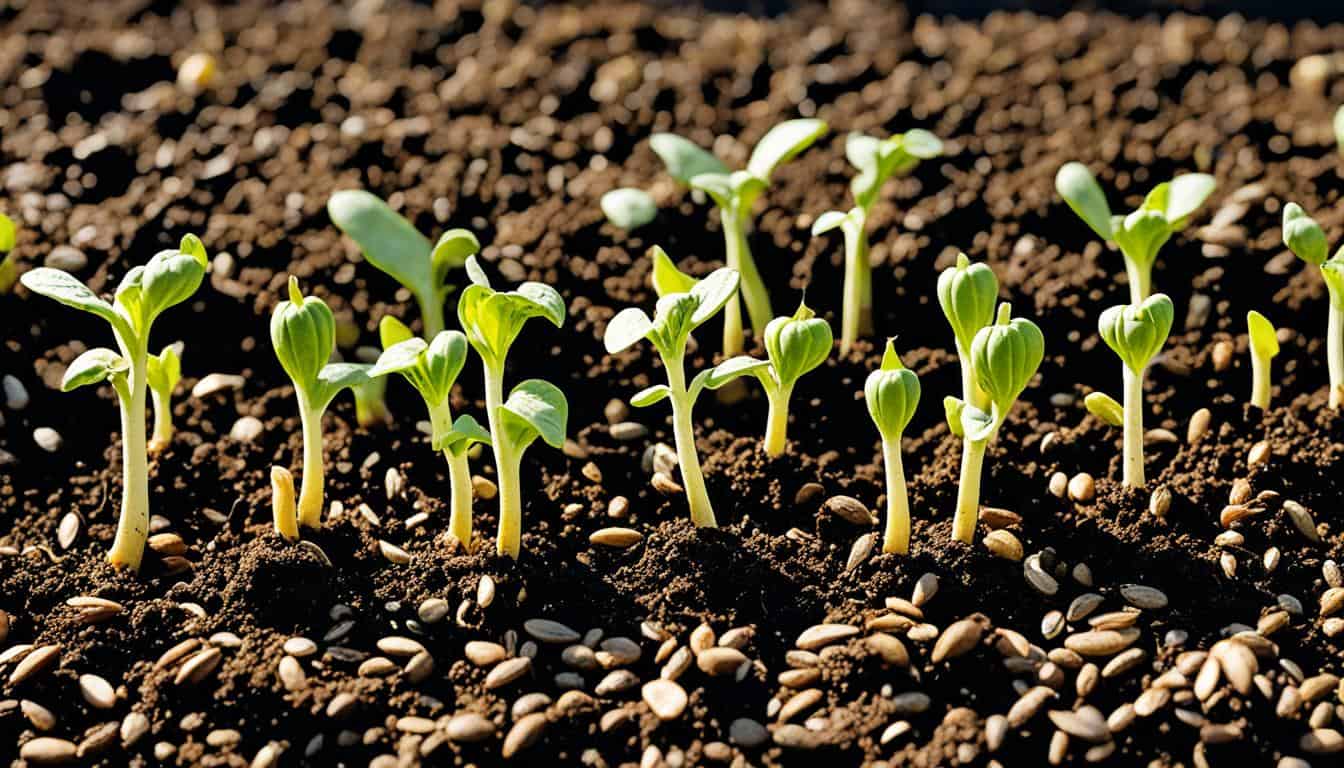
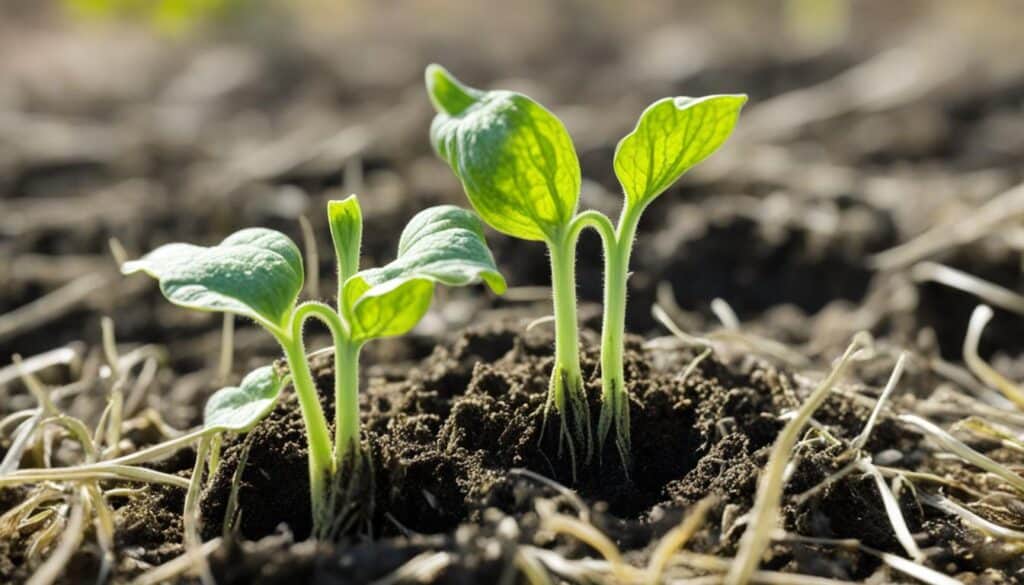
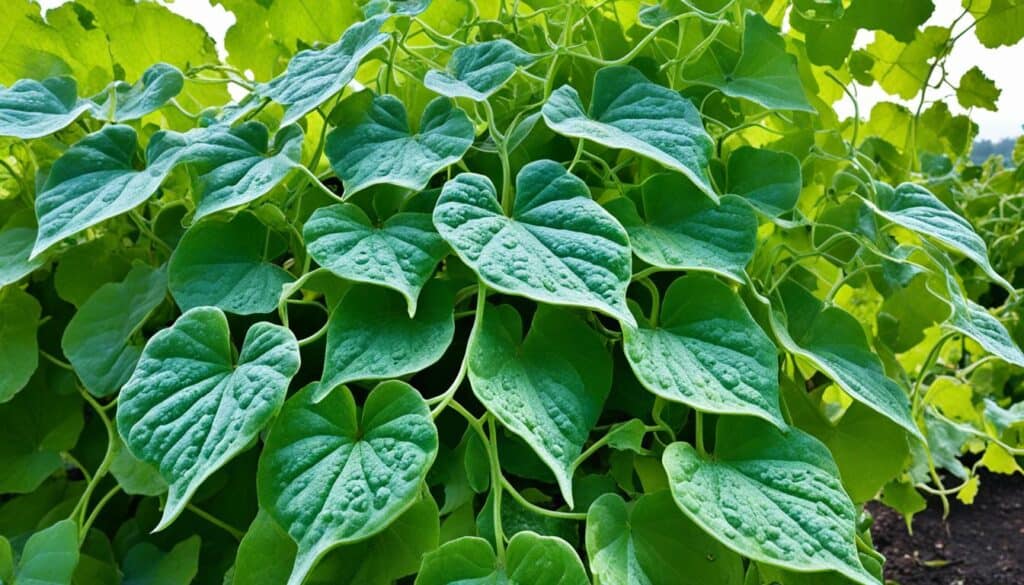
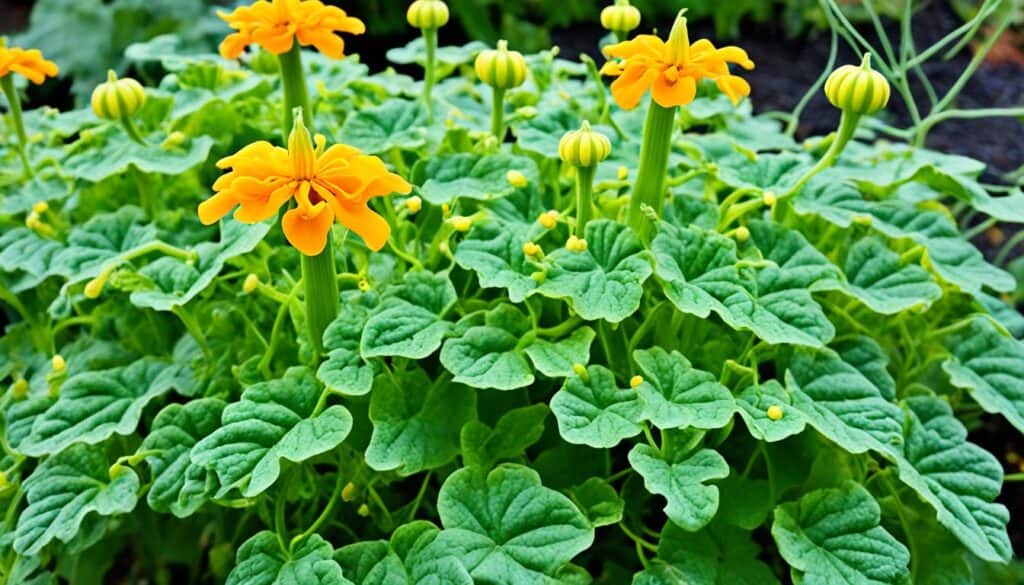
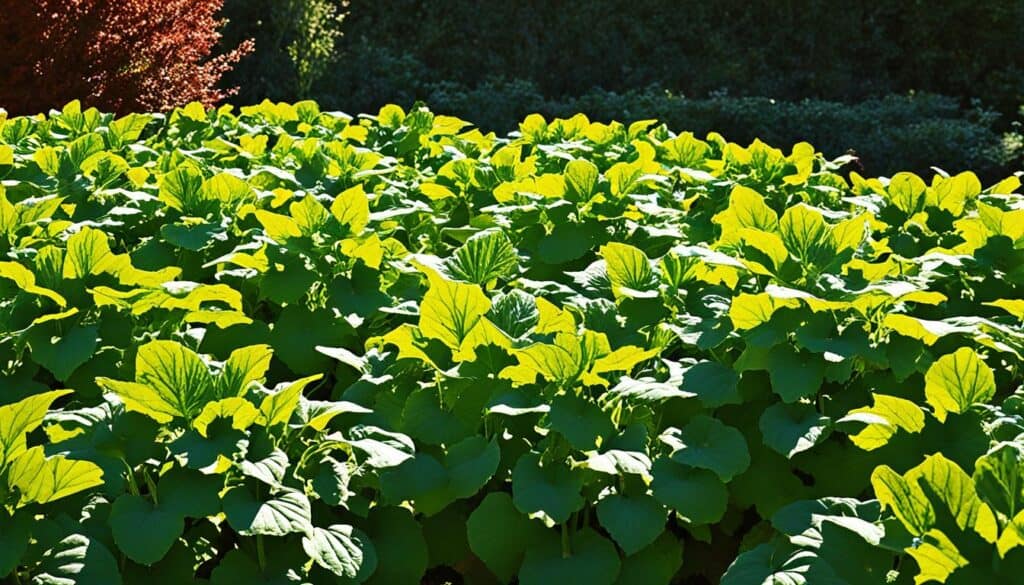




Leave a Reply